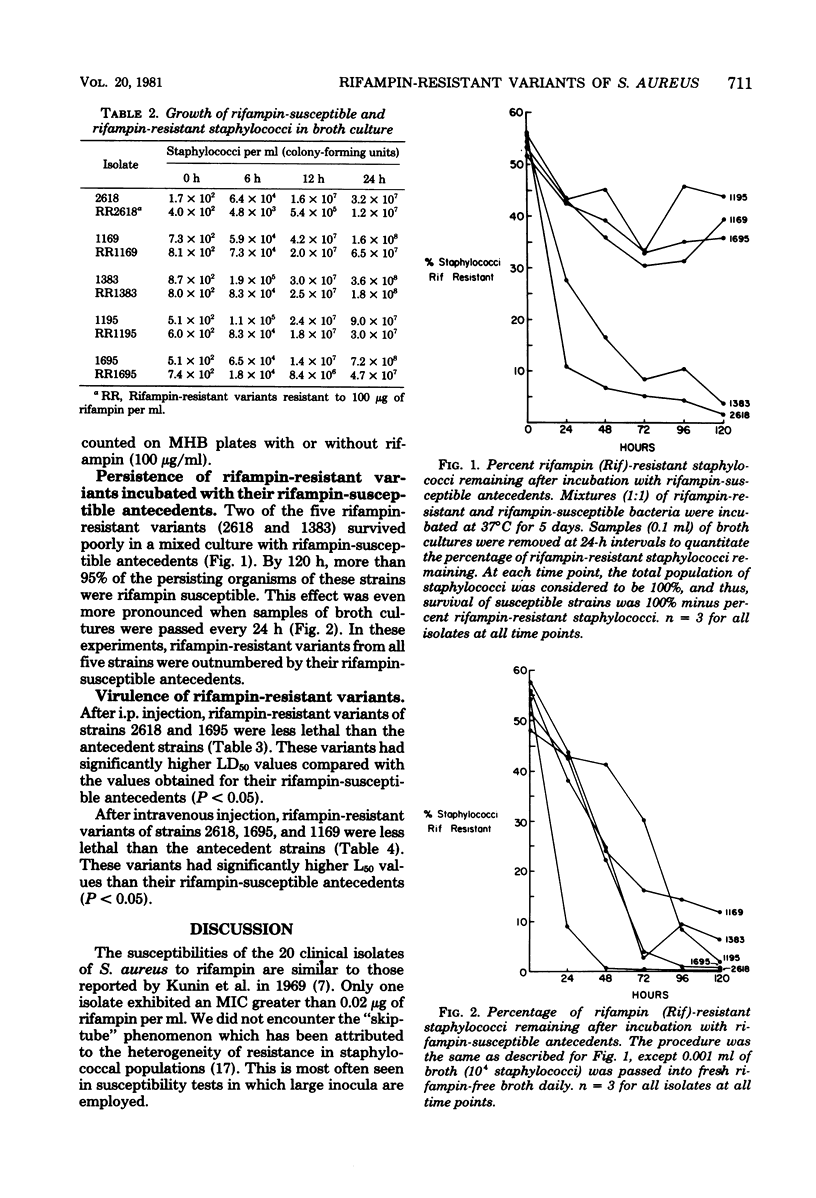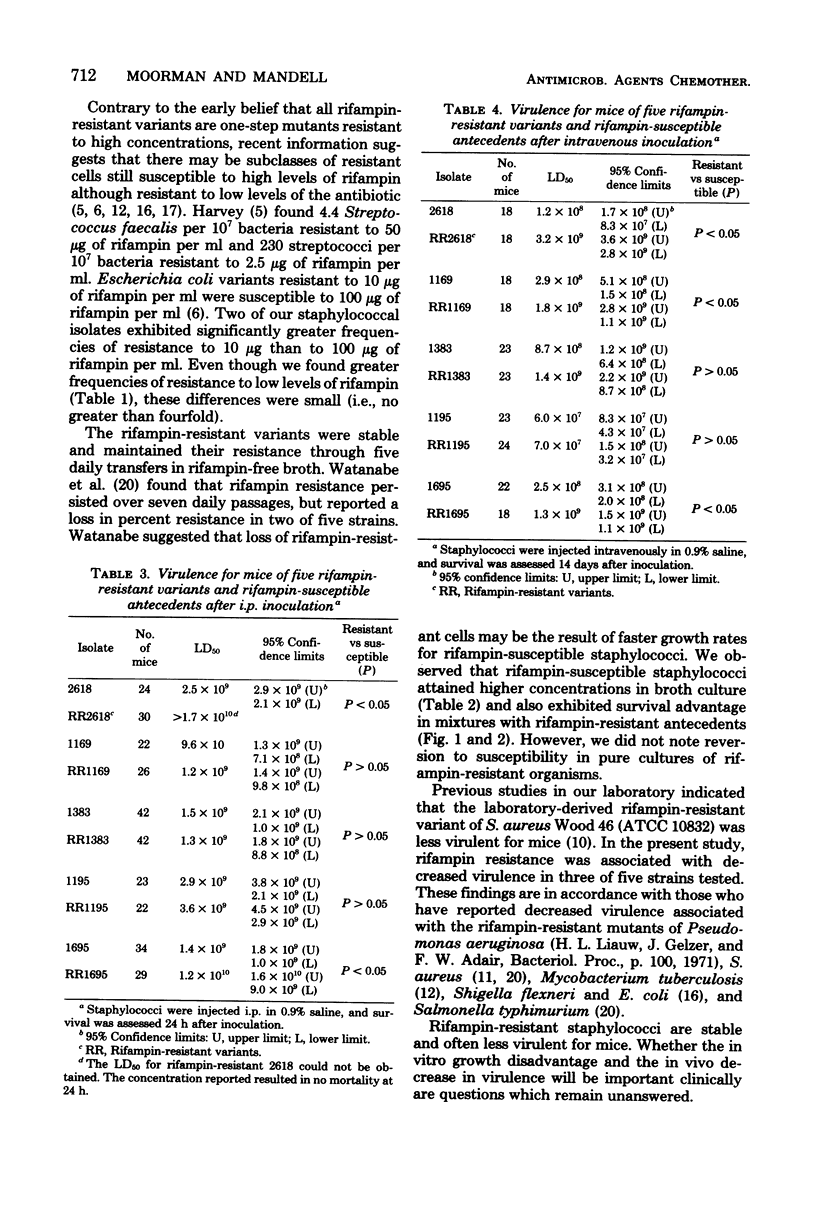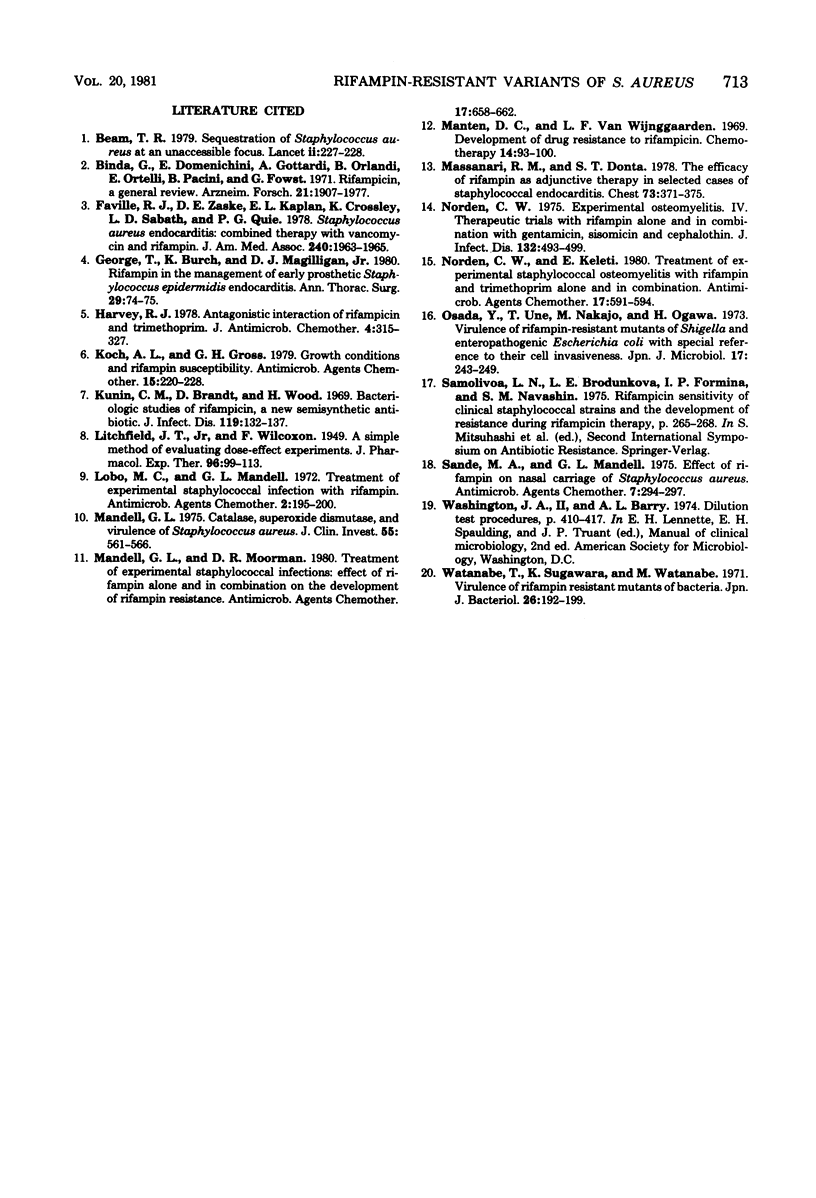Abstract
Twenty clinical isolates of Staphylococcus aureus were examined to determine the frequency of rifampin-resistant variants. All isolates were highly susceptible to rifampin, with mean minimum inhibitory concentrations of 0.11 +/- 0.1 microgram/ml and mean minimum bactericidal concentrations of 0.22 +/- 0.2 microgram/ml. The frequency of isolation of resistant variants was similar to all rifampin concentrations tested. Rifampin-resistant variants maintained their resistance upon daily subculture in rifampin-free broth. Rifampin-susceptible S. aureus exhibited a growth and survival advantage over the rifampin-resistant mutants both in pure cultures and in mixtures with rifampin-resistant antecedents. A comparison of the virulence for mice of five susceptible isolates and their 100 microgram/ml-rifampin-resistant variants showed that two of the resistant variants were less virulent than the susceptible strains via intraperitoneal challenge, whereas three of the resistant variants were less virulent by intravenous challenge (P less than 0.05).
Full text
PDF




Selected References
These references are in PubMed. This may not be the complete list of references from this article.
- Beam T. R., Jr Sequestration of staphylococci at an inaccessible focus. Lancet. 1979 Aug 4;2(8136):227–228. doi: 10.1016/s0140-6736(79)90239-3. [DOI] [PubMed] [Google Scholar]
- Binda G., Domenichini E., Gottardi A., Orlandi B., Ortelli E., Pacini B., Fowst G. Rifampicin, a general review. Arzneimittelforschung. 1971 Dec;21(12):1907–1977. [PubMed] [Google Scholar]
- Faville R. J., Jr, Zaske D. E., Kaplan E. L., Crossley K., Sabath L. D., Quie P. G. Staphylococcus aureus endocarditis. Combined therapy with vancomycin and rifampin. JAMA. 1978 Oct 27;240(18):1963–1965. doi: 10.1001/jama.240.18.1963. [DOI] [PubMed] [Google Scholar]
- George T., Burch K., Magilligan D. J., Jr Rifampin in the management of early prosthetic staphylococcus epidermidis endocarditis. Ann Thorac Surg. 1980 Jan;29(1):74–75. doi: 10.1016/s0003-4975(10)61632-3. [DOI] [PubMed] [Google Scholar]
- Harvey R. J. Antagonistic interaction of rifampicin and trimethoprim. J Antimicrob Chemother. 1978 Jul;4(4):315–327. doi: 10.1093/jac/4.4.315. [DOI] [PubMed] [Google Scholar]
- Koch A. L., Gross G. H. Growth conditions and rifampin susceptibility. Antimicrob Agents Chemother. 1979 Feb;15(2):220–228. doi: 10.1128/aac.15.2.220. [DOI] [PMC free article] [PubMed] [Google Scholar]
- Kunin C. M., Brandt D., Wood H. Bacteriologic studies of rifampin, a new semisynthetic antibiotic. J Infect Dis. 1969 Feb;119(2):132–137. doi: 10.1093/infdis/119.2.132. [DOI] [PubMed] [Google Scholar]
- Lobo M. C., Mandell G. L. Treatment of experimental staphylococcal infection with rifampin. Antimicrob Agents Chemother. 1972 Sep;2(3):195–200. doi: 10.1128/aac.2.3.195. [DOI] [PMC free article] [PubMed] [Google Scholar]
- Mandell G. L. Catalase, superoxide dismutase, and virulence of Staphylococcus aureus. In vitro and in vivo studies with emphasis on staphylococcal--leukocyte interaction. J Clin Invest. 1975 Mar;55(3):561–566. doi: 10.1172/JCI107963. [DOI] [PMC free article] [PubMed] [Google Scholar]
- Mandell G. L., Moorman D. R. Treatment of experimental staphylococcal infections: effect of rifampin alone and in combination on development of rifampin resistance. Antimicrob Agents Chemother. 1980 Apr;17(4):658–662. doi: 10.1128/aac.17.4.658. [DOI] [PMC free article] [PubMed] [Google Scholar]
- Manten A., Van Wijngaarden L. J. Development of drug resistance to rifampicin. Chemotherapy. 1969;14(2):93–100. doi: 10.1159/000220615. [DOI] [PubMed] [Google Scholar]
- Massanari R. M., Donta S. T. The efficacy of rifampin as adjunctive therapy in selected cases of staphylococcal endocarditis. Chest. 1978 Mar;73(3):371–375. doi: 10.1378/chest.73.3.371. [DOI] [PubMed] [Google Scholar]
- Norden C. W. Experimental osteomyelitis. IV. Therapeutic trials with rifampin alone and in combination with gentamicin, sisomicin, and cephalothin. J Infect Dis. 1975 Nov;132(5):493–499. doi: 10.1093/infdis/132.5.493. [DOI] [PubMed] [Google Scholar]
- Norden C. W., Keleti E. Treatment of experimental staphylococcal osteomyelitis with rifampin and trimethoprim, alone and in combination. Antimicrob Agents Chemother. 1980 Apr;17(4):591–594. doi: 10.1128/aac.17.4.591. [DOI] [PMC free article] [PubMed] [Google Scholar]
- Osada Y., Une T., Nakajo M., Ogawa H. Virulence of rifampicin-resistant mutants of Shigella and enteropathogenic Escherichia coli with special reference to their cell invasiveness. Jpn J Microbiol. 1973 Jul;17(4):243–249. doi: 10.1111/j.1348-0421.1973.tb00769.x. [DOI] [PubMed] [Google Scholar]
- Sande M. A., Mandell G. L. Effect of rifampin on nasal carriage of Staphylococcus aureus. Antimicrob Agents Chemother. 1975 Mar;7(3):294–297. doi: 10.1128/aac.7.3.294. [DOI] [PMC free article] [PubMed] [Google Scholar]
- Watanabe T., Sugawara K., Watanabe M. [Virulence of rifampicin-resistant mutants of bacteria]. Nihon Saikingaku Zasshi. 1971 Jun;26(5):192–199. doi: 10.3412/jsb.26.192. [DOI] [PubMed] [Google Scholar]


